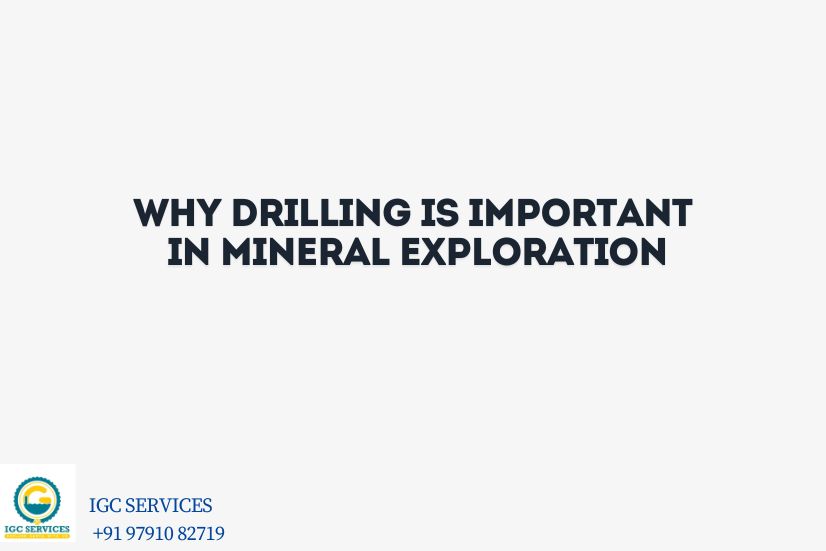
Mineral exploration is at the core of discovering valuable resources hidden beneath the earth’s surface, and IGC Services has been a leader in this field. As experts in mineral exploration, IGC Services specializes in identifying promising mineral deposits through innovative methods and state-of-the-art technology. Drilling plays an irreplaceable role in this process, allowing exploration teams to gather critical data from deep below the earth’s surface. This post will delve into why drilling is essential for successful mineral exploration and how techniques like core sampling, double tube barrels in soft rocks, and drilling in quartzite play key roles in achieving precise and valuable insights.
What is Drilling in Mineral Exploration?
Drilling in mineral exploration involves penetrating the earth’s surface to obtain samples and data on underground formations. It serves as a primary method for geologists and exploration teams to study mineral deposits, offering crucial information on the geology, mineralogy, and structure of rock formations. Various drilling methods cater to different exploration goals and rock types:
Rotary Drilling: Often used in early exploration, rotary drilling creates large-diameter holes to access initial information about the formation. It is quick but offers limited precision.
Diamond Drilling: Known for extracting core samples, diamond drilling uses a diamond-tipped drill bit to cut through rock and retrieve intact rock samples. This method is highly accurate and suitable for deep exploration.
Reverse Circulation (RC) Drilling: Primarily used in softer terrains, RC drilling is efficient and provides high-quality sample collection by forcing rock fragments up through the drill string, preventing contamination.
Each drilling type has unique applications depending on the depth, rock hardness, and goals of the exploration project.
The Importance of Drilling in Mineral Exploration
1. Access to Subsurface Information
Drilling is the only way to gather concrete data from deep below the earth’s surface. By drilling into target areas, geologists can evaluate the subsurface geology, gaining insights into the location, depth, and quality of mineral deposits. This is essential for calculating potential yields and planning extraction strategies, making drilling a cornerstone of effective mineral exploration.
2. Core Sampling
Core sampling is a specific type of drilling that retrieves a continuous cylinder of rock from the subsurface. The core sample provides an unbroken view of rock layers, allowing geologists to examine the mineral content, geological features, and structural conditions of the area in remarkable detail. This method is highly valuable for determining mineral concentrations and is essential for deciding if further exploration or mining is viable.
Core Sampling Techniques
Double Tube Barrels in Soft Rocks
Soft rock formations can be particularly challenging for drilling because they’re more prone to breakage and sample disturbance. The double tube barrel technique is designed to address this issue. With two tubes—one stationary and one rotating—the double tube barrel preserves the sample’s integrity by reducing friction and maintaining a clear passage for the core.
This technique provides accurate and undisturbed samples that are crucial for understanding soft rock formations’ geology. By preventing core loss and maintaining the sample’s structure, the double tube barrel method allows geologists to gain precise data on soft rock characteristics.
Drilling in Quartzite
Quartzite is one of the hardest and most challenging rocks to drill due to its durability and resistance. Effective drilling in quartzite requires specialized tools, such as diamond-encrusted drill bits, to cut through the dense material. Additionally, experienced drill operators are essential in handling the high wear and tear on equipment during quartzite drilling.
Using advanced equipment and techniques ensures accurate drilling, even in hard rock formations, which is crucial for exploring valuable mineral deposits in tough geological conditions.
Advantages of Drilling in Mineral Exploration
1. Accurate Data Collection
Drilling provides data that is both reliable and precise. The quality of information obtained from drilling surpasses other exploration methods, as it provides a tangible representation of subsurface conditions. This data is invaluable in making informed decisions about mineral extraction, helping exploration teams optimize resources and reduce risks.
2. Cost-Effective Exploration
While drilling has initial costs, it is often more cost-effective than other exploration methods, especially when exploring large or remote areas. By directly targeting specific locations and obtaining precise data, drilling minimizes the need for guesswork and reduces unnecessary exploratory activities, making it an efficient option for resource discovery.
3. Environmental Considerations
IGC Services prioritizes responsible drilling practices to protect the environment. Modern drilling projects employ eco-friendly lubricants, advanced waste management techniques, and procedures that minimize disturbance to the surrounding ecosystem. By using responsible practices, drilling can have a low environmental impact while still achieving exploration objectives.
Case Studies and Real-World Applications
IGC Services has successfully applied these drilling techniques in various mineral exploration projects, from identifying rich mineral veins in soft rock formations to overcoming the challenges of drilling in quartzite. For example, a recent project involving quartzite drilling revealed a significant mineral deposit that otherwise would have been inaccessible without specialized equipment and expertise. Another project utilized double tube barrel drilling to maintain core sample quality in soft rock, enabling a precise analysis that led to an accurate resource estimation.
These case studies underscore the impact of efficient drilling and highlight IGC Services’ role in helping clients discover valuable mineral resources through innovative exploration solutions.
Conclusion
Drilling is indispensable in mineral exploration, offering unparalleled access to subsurface information. Techniques such as core sampling, double tube barrels, and advanced drilling tools enable accurate and efficient exploration. By delivering reliable data, drilling supports resource estimates, cost-effective exploration, and responsible environmental practices. As a leader in mineral exploration, IGC Services is committed to using cutting-edge drilling technology to meet clients’ exploration needs, ensuring that each project is approached with precision, expertise, and care.
For those seeking expert support in mineral exploration, IGC Services stands ready to assist. Contact us to learn more about how our drilling solutions can help you achieve your exploration goals.
